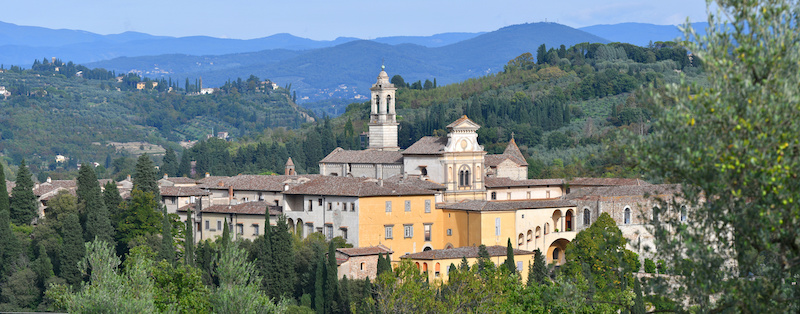If you are planning a stay in the charming city of Florence and have a few extra days beyond the usual weekend, you must include excursions out of town as extra stops on your trip. So, not only the historic center, with the infamous Uffizi Gallery, the Duomo, Santa Maria Novella, and the beautiful Boboli Gardens but also artistic heritage outside the city walls, nestled among the green hills around the city of the lily. Florence and its surrounding area indeed offer breathtaking views made famous by the paintings of some of the most renowned Italian artists and points of interest of the highest value.
A shining example of this is the Certosa di Firenze, or the Certosa del Galluzzo, located to the south of the city. Situated on a hilltop, atop Monte Acuto, this building of undeniable charm is one of the most famous Carthusian monasteries in Tuscany, built in the 14th century.
History: from Splendor to Decline to a New Beginning
The construction of the Certosa di Firenze is attributed to Niccolò Acciaiuoli, one of the wealthiest citizens of the city, who wanted to build the Certosa di Galluzzo in 1341, not only as a religious center but also as an educational institution for young Florentines. Since then, the Certosa has been inhabited by hundreds of monks who disseminated knowledge and wisdom here. During Napoleon’s time, the building was looted by French troops who plundered much of its artwork. After years of neglect, in 1957, a small group of Cistercian friars replaced the Carthusian monks as residents of the Certosa, maintaining their ancient traditions, such as the distillation of herbal liqueurs and the production of small handmade religious articles, to this day.
What to See at Certosa di Firenze
The complex of the Certosa di Firenze is divided into three areas: the monastery, the Acciaiuoli Palace, and the Church of San Lorenzo.
The first building you encounter is the Acciaiuoli Palace, commissioned by Niccolò Acciaiuoli, who, however, did not live to see the palace completed, as he died when only the first floor was built. The palace was completed only around the mid-16th century. The old part of the building houses the restoration workshops of the Vieusseux Library, while the lower level houses the art gallery.
The monastery, unlike the Acciaiuoli Palace, was completed in a few years and consecrated in 1395; the subsequent centuries saw it undergo significant expansions and modifications, which continued until the end of the 17th century.
The Church of San Lorenzo is one of the clearest examples of Mannerist architectural style, rich in frescoes and paintings; it houses a crypt containing numerous tombs, mainly of the Acciaioli family. Inside the church, at the end of the corridor, you can admire Andrea della Robbia’s Christ Carrying the Cross and the elegant little cloister that serves as the focal point of the entire complex. From here, a door, decorated by Saint Lawrence between two angels in terracotta by Benedetto da Maiano, leads to the refectory, in the main cloister, and to the chapter house, where the monks gathered to discuss issues concerning their community.
The main Monks’ Cloister is characterized by the 18 cells where the Carthusian monks spent much of their lives, only leaving for Mass and meals on feast days. These cells, open to the public, offer visitors an idea of Carthusian monastic life: each cell consists of a room for sleeping and a room for prayer. The furnishings are very austere, but each monk could have a small private garden that was individually cultivated.
Visiting Hours
The interior of the Certosa di Firenze can be visited through guided tours lasting about an hour.
Guided tours of the Certosa di Firenze are held from Tuesday to Saturday at 10:00, 11:00, 15:00, 16:00, 17:00, while on Sundays, they are only held in the afternoon, at 15:00, 16:00, and 17:00.


